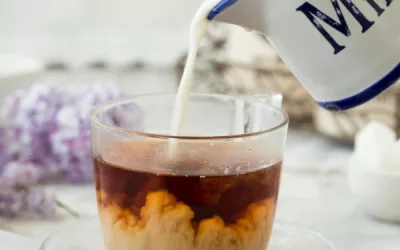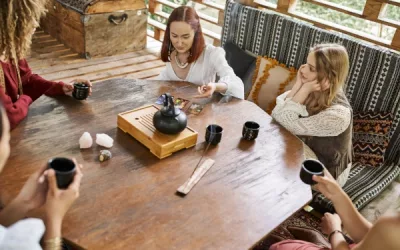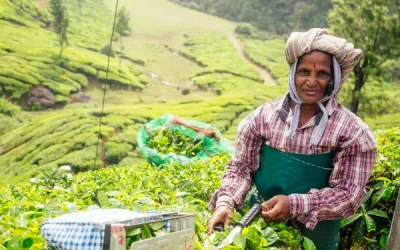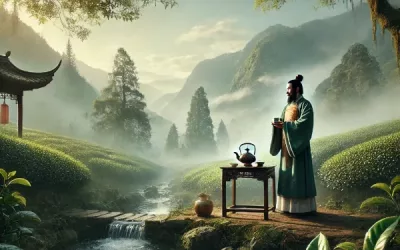Did you know that the word “tea” has roots that stretch back to ancient China and has evolved through centuries of trade and cultural exchange? This exploration into the etymology of tea unveils not only the linguistic journey of this beloved beverage but also its significant role in various societies around the globe. Understanding the diverse ways in which tea is named and celebrated reveals much about our cultural identities. Join me as we trace the fascinating history and cultural significance of tea, illuminating its profound impact on our world.
Table of Content
- What is the origin of the word ‘tea’?
- How does the word ‘tea’ differ across various languages?
- What cultural significance does tea hold in different societies?
- How did trade routes influence the spread of tea?
- What are the phonetic variations of ‘tea’ in different dialects?
- Can ‘chai’ refer to different types of tea?
- What historical events contributed to the popularity of tea globally?
- How does the etymology of tea relate to its cultivation and consumption?
- Conclusion
What is the origin of the word ‘tea’?
The word ‘tea’ has fascinating origins that trace back to ancient China. The primary Chinese roots of the word are the Min Chinese term ‘te’ and the Cantonese ‘cha’. These terms emerged from different Chinese dialects and travelled around the globe, largely due to cultural exchanges and trade activities. Portuguese traders played a significant role in spreading these terms to Europe, where the English term ‘tea’ eventually evolved.
The Min Chinese term ‘te’ originates from the Hokkien dialect. This term was used in the coastal Fujian province, where European traders first encountered dried tea leaves.
On the other hand, ‘cha’ comes from the Cantonese, which is prominent in the Guangdong province. These terms were adopted in various forms by numerous languages as tea spread worldwide.
What are the different Chinese terms for tea?
- Min Chinese: ‘te’
- Cantonese: ‘cha’
- Mandarin: ‘chá’
- Wu Chinese (Shanghainese): ‘zo’
- Korean: ‘cha’
These diverse terms show how languages adapt and modify words based on regional dialects and usage. The Min Chinese term ‘te’ heavily influenced European languages like English, Dutch, and French, while ‘cha’ influenced languages like Arabic, Russian, and Hindi.
How did the word ‘tea’ evolve in English?
When the Portuguese began trading with China in the 16th century, they encountered the Cantonese term ‘cha’. However, it was the Dutch traders who popularised the Min Chinese term ‘te’ in Europe. The English eventually adopted the word ‘tea’ from the Dutch ‘thee’.
As tea became a fashionable beverage in Britain, the term solidified its place in the English language.
- First, Portuguese traders brought ‘cha’ to Europe.
- Next, Dutch traders used ‘te’, influencing many European languages.
- English adopted ‘tea’ from the Dutch ‘thee’.
- The term quickly spread, becoming a staple in British culture.
The evolution of the word ‘tea’ in English reflects the dynamic nature of linguistic exchange and cultural interaction.
What role did trade play in the word’s transmission?
Trade was the critical factor in spreading the word ‘tea’. The Portuguese were the pioneers, establishing early trade routes with China. However, the Dutch East India Company played a more significant role.
They imported tea to Europe on a large scale, introducing the Min Chinese term ‘te’ to the continent.
- Portuguese traders began the initial exchange, using ‘cha’.
- Dutch traders expanded the trade, popularising ‘te’.
- Tea became a luxury item in Europe, influencing local terms.
- Other trading nations like Britain adopted these terms, solidifying ‘tea’ in English.
- The global spread of tea led to various adaptations of the word in different languages.
Trade routes functioned as linguistic highways, transmitting not only goods but also words and cultural practices.
In the 17th century, Catherine of Braganza, the Portuguese princess who married King Charles II of England, played a significant role in popularising tea in Britain.
She brought her love for tea from Portugal and made it fashionable in the British court. This influence significantly boosted tea’s status and solidified the term ‘tea’ in English society.
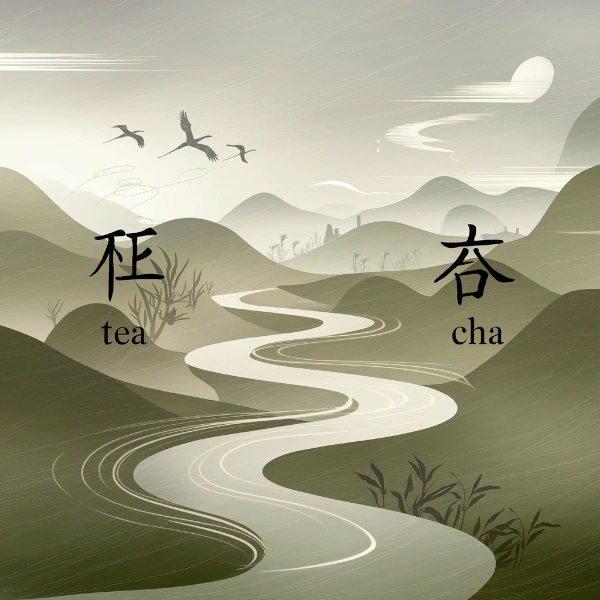
How does the word ‘tea’ differ across various languages?
Tea, a beloved beverage enjoyed worldwide, has a fascinating journey reflected in its name across different languages. The word “tea” has two primary etymological origins: the Chinese “cha” and “te.”
These roots have branched out to various languages, showcasing the cultural and historical exchanges that have taken place over centuries.
The variation in the word for tea in different languages can tell us a lot about trade routes and historical interactions between cultures. Some languages have adopted a version of “cha,” while others have a variant of “te.”
This distinction often indicates how the word spread geographically, as traders introduced tea to different regions.
Below is a table that shows the word for tea in several languages, along with its phonetic pronunciation and the language family it belongs to.
This table can help you understand how the word for tea varies across cultures and the linguistic connections between them.
Table: Linguistic Variations of the Word ‘Tea’
| Language | Word for Tea | Phonetic Spelling | Language Family |
|---|---|---|---|
| English | Tea | tee | Indo-European |
| Mandarin | 茶 | chá | Sino-Tibetan |
| Japanese | お茶 | o-cha | Japonic |
| Russian | Чай | chai | Indo-European |
| Arabic | شاي | shay | Afro-Asiatic |
| Hindi | चाय | chai | Indo-European |
| Turkish | Çay | chay | Turkic |
| Swahili | Chai | chai | Niger-Congo |
| Korean | 차 | cha | Koreanic |
| Portuguese | Chá | sha | Indo-European |
| French | Thé | tay | Indo-European |
To use this table, identify the language of interest in the first column. The second column shows the word for tea in that language. The third column provides the phonetic spelling, helping you pronounce the word correctly.
Finally, the fourth column indicates the language family, revealing linguistic relationships.
What are the origins of ‘cha’ and ‘te’?
The words “cha” and “te” both originated from China, but they spread through different routes and times:
- Cha: Originating in Northern China, the word “cha” spread along the Silk Road to Central Asia, the Middle East, and eventually Europe.
- Te: This variant emerged in Southeast China, specifically along the coast, and spread through maritime trade routes to countries like Japan, Portugal, and France.
The different routes of dissemination explain why some cultures use “cha” while others use “te.” Language families and regional adaptations further influenced these variations.
How does historical trade impact the etymology of tea?
Trade routes have significantly impacted the evolution of the word “tea” across languages. Here’s how:
- Silk Road Influence: The overland Silk Road facilitated the spread of “cha” to Central Asia, the Middle East, and Russia.
- Maritime Trade: The maritime routes used by Dutch and Portuguese traders led to the spread of “te” to Europe and Japan.
These historical trade routes not only influenced language but also cultural exchanges, technology, and culinary practices.
In the early 17th century, the Dutch East India Company played a significant role in popularising tea in Europe. The Dutch traders brought tea from China to the Netherlands, and from there, it spread to other parts of Europe.
They mainly interacted with Chinese ports that used the Min Nan dialect, which pronounced the word as “te.” This led to the adoption of the word “tea” in many European languages.
What cultural significance does tea hold in different societies?
Tea is more than just a beverage; it’s a whole cultural experience. Whether it’s the refined tea ceremonies in Japan, the iconic British afternoon tea, the deep-rooted traditions in Chinese culture, or the aromatic chai in India, tea holds a special place in people’s hearts and histories around the globe. Let’s take a little trip around the world and unfold the leaves of tea’s cultural significance.
Tea ceremonies in Japan
In Japan, tea isn’t just dunking a bag in hot water. Oh no, my friend! It’s a sacred ritual known as “chanoyu” or “sado,” involving meticulous preparation and presentation of matcha (powdered green tea). Passed down through generations, these ceremonies are deeply connected to Zen Buddhism.
Attributes of Japanese tea ceremonies:
- Zen Buddhism roots: Reflecting tranquillity and mindfulness.
- Meticulous preparation: Every move choreographed to perfection.
- Special utensils: Bamboo whisk, tea bowl, and tea scoop.
- Seasonal elements: Changes in utensils and decor to match the seasons or occasions.
- Forms of gratitude: Bowing, exchanging pleasantries, and appreciating the moment.
It’s a dance with tea where each step, each gesture, stands symbolic of ritual and tradition. It’s less about sips and gulps and more about appreciating the aesthetics, mindfulness, and respect for the host and guests.
The British afternoon tea tradition
Move over, siesta! The Brits have their own leisurely tradition – afternoon tea. Originating in the early 19th century, it’s a refined yet relaxed event between lunch and dinner, often enjoyed with an assortment of sandwiches, cakes, and scones. Above all, it’s an excuse to gossip and socialise.
Highlights of British afternoon tea:
- Finger sandwiches: Cucumber, smoked salmon, and other dainty delights.
- Scones: Served with clotted cream and jam, preferably strawberry.
- Pastries and cakes: A platter of sugary treats.
- Tea varieties: From Earl Grey to Darjeeling, always served in fine china.
- Social setting: A chance to catch up, discuss the weather, or simply relax.
So, whether you’re a lord, lady, or commoner, afternoon tea envelops you in a realm of elegance, conversation, and, of course, the perfume of freshly brewed tea.
The role of tea in Chinese culture
In China, tea isn’t just a drink; it’s a way of life. With a history dating back thousands of years, tea represents harmony, respect, purity, and tranquillity. It even has a whole “tea art” scene known as “Gongfu tea ceremony,” which is as serious as its name sounds.
Pillars of Chinese tea culture:
- Gongfu cha: Detailed brewing process with small pots and multiple steeps.
- Cultural symbol: Reflects Chinese philosophy, health, and wisdom.
- Tea houses: Places where people gather, sip tea, play games, and relax.
- Wide varieties: Green, black, white, oolong, and more.
- Medicinal uses: From aiding digestion to boosting immunity.
Tea in China fosters connections, brings people together, and is often entwined with ceremonies, celebrations, and personal well-being.
The significance of chai in India
Chai is to India what oxygen is to survival. Every street corner has a “chaiwallah” offering a steaming cup of spiced tea that soothes souls and sparks conversations. It’s part of daily life and is infused with spices like cardamom, ginger, and cloves, making it a sensory delight.
Elements of Indian chai:
- Spices: A blend of cardamom, ginger, cloves, and sometimes cinnamon or fennel.
- Milk and sugar: Creamy and sweet; no delicate sips, just hearty slurps.
- Street culture: Chai stalls where folks gather, chat, and unwind.
- Home gatherings: An integral part of hospitality.
- Chai breaks: Office goers, students, and virtually everyone pause for their chai fix.
Chai isn’t just a drink in India; it’s a comfort, an energiser, and a bonding agent.
Where there’s tea, there’s conversation. This humble beverage has the power to bring people together, break the ice, and kindle relationships. From formal tea parties to casual chai breaks, tea often plays the role of social lubricator.
- Conversation starter: “How do you like your tea?” often leads to deeper chats.
- Hospitality symbol: Offering tea is a universal gesture of welcome.
- Celebration essential: Birthdays, weddings, and other festivities feature tea.
- Stress reliever: Sharing a tea break can diffuse tension and foster friendliness.
- Cultural bridge: Tea traditions can introduce you to new customs and cultures.
The act of sharing tea, whether in grand ceremonies or street-side stalls, cultivates connections and creates memorable moments.
Let’s not forget when Catherine of Braganza, a Portuguese princess, married King Charles II of England in the 17th century. She brought along her love for tea, which was then an exotic luxury.
Her habit caught on with the British aristocrats, and the rest, as they say, is history. Thanks to her, the British and their teapots have been inseparable ever since!
So, pour yourself a cup, and as you savour that brew, take a moment to appreciate the global journey and cultural significance that every sip encapsulates.
How did trade routes influence the spread of tea?
Trade routes, my friend, have been like the postmen of history, delivering more than just your Amazon parcels. They carried ideas, spices, diseases (bummer, I know), and yes, tea.
Think of the Silk Road and maritime pathways as the ancient superhighways through which this fragrant brew travelled the world. So, buckle up as we embark on a journey from China’s leafy plantations to your steaming cup of Earl Grey.
From ancient China, tea inched its way through the Silk Road, snaking through Central Asia, and managed to hitch a ride on ships that sailed the high seas.
But it wasn’t just Asians embarking on tea voyages; European colonial powers took tea-lust to new heights. These knuckleheads (or masterminds, depending on your view) played a starring role in turning tea into a cultural phenomenon.
What were the key trade routes for tea?
Tea didn’t just waltz into the global spotlight; it took some serious travelling. The Silk Road and various sea routes were the rock stars of tea commerce. Here’s a breakdown:
- The Silk Road: Not just for silk! This transcontinental highway linked China to Europe, with tea as a prized cargo. Caravans trudging through deserts and crossing treacherous mountains were all in a day’s work.
- Maritime routes: The sea was no obstacle—China to Europe via the Indian Ocean became a tea trader’s dream. Ports like Calcutta, Madras, and Canton were key stops.
- Dutch Trade Routes: The Dutch East India Company jumped on the tea bandwagon early, setting up shop in Java and later, bringing tea to Europe.
- British Sea Routes: The monopoly holders of the tea trade. They established routes from India and Ceylon (now Sri Lanka), flooding Europe with tea.
- Portuguese Influence: Early birds in the Eastern trade game—they initially brought tea to Europe from their colonies.
These trade routes were more than mere paths; they were the arteries pumping lifeblood into international tea-drinking habits.
Historically, even as tea was making a name for itself, European powers were scrambling for a piece of the action.
How did European powers influence tea trade?
If you’re thinking pirates and treasure maps, sort of but with posh accents and powdered wigs. The British, Dutch, and Portuguese muscle-flexing in tea trade were nothing short of a Game of Thrones episode.
- British East India Company: Monopoly and muscle. They controlled the tea trade from China and later, cultivated their own in India. This led to the Opium Wars and the opening of more Chinese ports for trade.
- Dutch East India Company: The tea trailblazers in Europe, even if the British later eclipsed them.
- Colonial Ambitions: The scramble for Africa was nothing compared to the scramble for tea-producing regions. Colonial powers set up plantations in India, Ceylon, and Java.
- Trade Wars: The British and Chinese had different understandings of commerce—cue the Opium Wars, with the Brits demanding open trade routes.
- Cultural Shifts: Tea in the colonies gave rise to an integration of local and foreign customs. Hello, chai!
The Europeans weren’t tea’s only fans—they essentially became tea’s global brand managers.
So, how did this trade extravaganza influence how much tea people drank?
What effect did trade have on tea consumption patterns?
With trade routes buzzing like a caffeinated bee, tea became more than a drink; it was a lifestyle. Believe it or not, trade impacted tea-drinking habits drastically.
- Widespread Availability: More trade routes meant more tea reaching distant lands. From a rare delicacy to a household staple.
- Affordability: Increased supply meant lower prices. Goodbye exclusivity, hello, everyday brew!
- Cultural Integration: Tea became part of local customs. Think of the Japanese tea ceremony, British afternoon tea, and Middle Eastern mint tea rituals.
- Variety Explosion: Different regions began cultivating their own tea varieties. Enter green, black, oolong, and everything in between.
- Social Status: Tea-drinking was initially a mark of high society in Europe, later trickling down to the masses.
The ripple effect of trade on consumption can be seen in how tea went from being an Eastern luxury to a global necessity.
Around the mid-17th century, Catherine of Braganza, the Portuguese queen married to England’s Charles II, brought her fondness for tea with her to the English court.
She wasn’t just Charles’ better half; she became the poster girl for tea culture in Britain. As tea started making waves in royal circles, it trickled down through the nobility, landing eventually in everyday British homes.
This was a groundbreaking moment for tea, and Queen Catherine, with her cup perpetually in hand, turned the tide for the English tea-drinking tradition that we still see today.
What are the phonetic variations of ‘tea’ in different dialects?
Alright, tea enthusiasts and linguistics buffs, let’s take a sip and dive into the phonetic rollercoaster ride that is the word ‘tea.’ Trust me, it’s more stimulating than your morning cuppa.
From vastly different Chinese dialects to quirky regional accents, ‘tea’ has more phonetic twists than a soap opera plot. Get ready to revel in some delightful dialect drama.
Imagine you’re at a Chinese tea house where even ordering a simple cup of ‘tea’ can get linguistically tangled. Mandarin speakers would ask for ‘chá’ (茶), with that rising tone that makes you sound like you’re about to ask a question.
Then, you’ve got Cantonese speakers calling it ‘chàh,’ but with that smooth, steady tone. But wait, there’s more; Min Nan speakers who come in and drop a ‘dê’ or ‘tê,’ depending on how fancy they’re feeling.
Regional accents, oh my! Let’s jaunt over to the UK, where a Yorkshireman’s ‘tea’ sounds starkly different from how a Londoner casually drops it.
Phonetic variations introduce such a rich tapestry of sounds that it feels like you’re listening to a symphony of linguistic diversity. Essentially, each variation tells a small story of cultural exchange just within a single syllable.
Pretty cool, huh?
How does pronunciation differ in Chinese dialects?
In the 26 letters of the English alphabet and numerous Chinese characters, tiny tonal shifts make a world of difference. In Chinese dialects:
- Mandarin: ‘chá’ is pronounced with a rising tone like you’re about to ask, “Really?”
- Cantonese: ‘chàh’ is spoken more steadily, with an air of assertiveness.
- Min Nan: Can go for either ‘dê’ or ‘tê’—I know, confusing, but hang in there.
- Wu: Sometimes opts for ‘zò,’ throwing a real wildcard into the mix.
Intriguingly, these phonetic shifts are more than just accents or quirks. They underpin complex cultural exchanges that span centuries.
If you ever find yourself negotiating a tea purchase in Shanghai or Guangzhou, knowing these phonetic distinctions could mean the difference between a jasmine-scented masterpiece and a puzzled stare.
What impact do regional accents have on the word?
Moving over to the land of awkward weather and endless cups of Earl Grey, let’s dissect how accents influence ‘tea.’
- London: Efficiently clipped as ‘tee.’
- Yorkshire: You’d hear it as ‘tay,’ often in the same breath as the word ‘love.’
- Geordie: It’s more like ‘tee-ee,’ with a jovial bounce.
- Scottish: Think ‘tay’ but with a bit more roll of the ‘r’ for character.
With accents, what’s fascinating is how much they reveal about regional identity. Say ‘tea’ in Liverpool, and you paint a picture of a laid-back afternoon.
Say the same in Glasgow, and it’s an invitation to a hearty chat. Accents offer glimpses into local cultures shaped by history, geography, and community—you know, the small stuff.
Why are phonetic variations important for cultural studies?
So, why should you care about these phonetic contortions, dear reader? Simple. They unlock doors to understanding cultural narratives and the flow of ideas.
- Cultural exchange: Each phonetic variation carries traces of cultural interaction—be it via trade, migration, or colonisation.
- Historical insight: Understanding pronunciation can offer clues about historical connections; for instance, how the British East India Company’s trade routes influenced global tea culture.
- Social identity: Pronunciation indicates social belonging, distinguishing not just from outsiders but also akin community members.
These variations aren’t just mere quirks; they’re vital keys to decoding the rich tapestry of global culture in one sip, slurp, or gulp.
Picture this: In the mid-17th century, the Dutch East India Company was the Starbucks of the sea lanes, trading tea far and wide. They brought tea to Europe, dubbing it ‘thee,’ thanks to the Min Nan ‘tê’ they picked up in Fujian.
The Portuguese, trading out of Macau, preferred the word ‘chá,’ as echoed in Mandarin. This divergence in ‘tea’ versus ‘chá’ found its way through Europe and beyond, marking a fascinating fork in linguistic roads—all from a simple leaf brewed in hot water.
So, next time you brew a cup, remember, it’s not just about quenching your thirst—it’s about tasting a spoonful of global history in every sip. Cheers to that!
Can ‘chai’ refer to different types of tea?
Oh, the mystical world of tea! Or should we say, ‘chai’? Yes, our beloved ‘chai’ can indeed refer to different types of tea, depending on where you are on this spinning globe. Let’s unravel the steaming hot details.
The multifaceted ‘chai’
In India, ‘chai’ is more than just a beverage; it’s practically a cultural institution. It’s not your plain old tea, oh no. It’s a robust concoction involving black tea, a riot of spices like cardamom, cinnamon, ginger, and cloves, mixed with milk, and sweetened to perfection.
It’s the stuff that fuels conversations on street corners and powers through the tedious moments of daily life.
In Western contexts, the term ‘chai’ often conjures images of a fancy ‘chai latte’, which is basically the Indian version but with a lot more froth and, usually, a price tag that makes you wonder if you’re paying for liquid gold.
Here, ‘chai’ is the trendy cousin of regular tea, often found competing with pumpkin spice lattes and other café classics.
Culturally, ‘chai’ in India isn’t just a drink; it’s a ritual. Offering a cup of chai is akin to extending a hand of friendship, a gesture of hospitality. In Western culture, it has become a chic, somewhat exotic drink with a hipster flair.
The global popularity of ‘chai lattes’ has even given traditional tea a run for its money.
So, while ‘chai’ can undoubtedly refer to different types of tea, it carries a distinct aroma of cultural history wherever it goes.
What does ‘chai’ typically refer to in India?
In India, ‘chai’ is a way of life. It’s not just about sipping; it’s about savoring. It typically refers to a spiced, milky, sweet tea that is so ingrained in the culture, it practically courses through the veins of its people.
- Ingredients: Black tea leaves, milk, sugar, and spices like cardamom, cinnamon, and cloves.
- Social glue: A catalyst for conversations, from street vendors to palatial homes.
- Daily ritual: Consumed by the gallons; from morning until night, chai is the fuel.
- Cultural significance: Integral part of hospitality; a universal invitation.
- Economic engine: Roadside chai stalls, known as ‘tapris’, are small business lifelines.
This small cup of spiced joy is cherished at any time of the day and offered as a gesture of warmth and friendliness. It’s your unofficial entry ticket to India’s diverse socio-cultural fabric.
How is ‘chai’ perceived in Western cultures?
Step into a Western café and ask for ‘chai’, and behold—you’re handed a sleek, fancy chai latte. It’s a bit frillier than its Indian cousin, but it still tries to pack in some Eastern promise (with extra froth and prettier packaging).
- Chai latte love: Frothy, sweetened version often spiked with vanilla or other syrups.
- Hipster heaven: A trendy choice among the avocados-on-toast crowd.
- Cultural token: Seen as exotic, bringing a touch of mystique.
- Steamy competition: Competes with other café classics like lattes and cappuccinos.
- Accessible luxury: Often served in stylish settings, as a premium beverage.
In the Western world, ‘chai’ is perceived as an upscale, fashionable choice, often enjoyed in cosy coffee shops and paired with a good book or Wi-Fi, adding an exotic twist to their beverage repertoire.
What are the cultural implications of the term ‘chai’?
‘Chai’ carries a cultural backpack wherever it goes, loaded with nuances and stories. It’s not just a term; it’s a bridge between worlds.
- Cultural exchange: Shows the movement and adaptation of cultural practices.
- Globalisation: Reflects the spread and adaptation of culinary traditions.
- Heritage and identity: Maintains Indian cultural identity while adapting to global tastes.
- Economic impact: Supporting small vendors in India and entrepreneurs globally.
- Symbolic meaning: Acts as a symbol of hospitality and warmth on a global scale.
This wondrous brew connects cultures and people, awakening taste buds and acting as a dialogue between East and West. Its implications stretch beyond just a drink; it delves into heritage, globalisation, and economics.
In the 17th century, a fleet of Portuguese merchants returned from Asia with a precious cargo: tea leaves. Initially met with scepticism, these leaves soon became the cornerstone of British tea culture.
It’s ironic, really, that a drink synonymous with British etiquette was embraced through colonial trade connections. As you sip your chai or tea, you’re part of a narrative that’s been brewing for centuries. Isn’t that just marvellous?
What historical events contributed to the popularity of tea globally?
Tea is more than just a beverage; it’s a historical voyage in a cup. This journey has roots tangled with global conquests, wars, and revolutions. Let’s spill the tea on how worldwide events brewed a love for this drink.
First sip, Europeans discovered tea in the 16th century and couldn’t get enough of it, thanks to traders like the Dutch and the Portuguese. Faster than you can say “Afternoon Tea,” it spread like wildfire among the European elite.
Then, tension boiled over with the Opium Wars in the mid-19th century, when the British decided it was high time China stopped being their sole supplier.
They balanced the scales of trade deficit by pumping opium into China in exchange for tea, setting off two wars and unfurling the opium addiction catastrophe in China.
Hop across the pond to America, where the Boston Tea Party saw patriots dump vast amounts of tea into the harbour in 1773. This dramatic statement against British taxation without representation was a catalyst for the American Revolution.
Colonialism also had its part to play. The British Empire fancied tea so much they set up tea plantations in India and Sri Lanka. They stopped relying on Chinese tea and started sourcing it from their colonies, further embedding tea into the fabric of their culture.
Tea has grown to be a global commodity, thanks in no small part to these major historical events. So, just think about that next time you take a sip.
How did the Opium Wars affect tea trade?
The Opium Wars shook the landscape of global trade like a caffeinated earthquake. The British, hungry for tea but burdened by a trade imbalance, found their golden ticket in opium. Cue the underhanded tactics.
- The British exported opium to China to fund their growing demand for Chinese tea.
- China was drowning in opium addiction, leading to governmental action against British trade.
- Out came the guns; conflict ensued between Britain and China in two separate wars (1839-1842 and 1856-1860).
- The Treaty of Nanking (1842) and subsequent treaties forced China to open up ports and ceded Hong Kong to Britain.
- These events changed the dynamics of trade, solidifying British control and opening up new trade avenues for tea.
The aftereffect? Britain got tremendous quantities of tea, with a little bit less care about the societal mayhem they left in their wake.
What role did the Boston Tea Party play in American history?
The Boston Tea Party wasn’t your ordinary temper tantrum. Americans, frustrated with British taxes and laws, decided to put their foot down—right in the middle of Boston Harbour.
- Significant event in 1773 was a protest against the Tea Act imposed by Britain.
- Colonists, dressed up as Native Americans, boarded British ships and dumped 342 chests of tea into the harbour.
- This defiant act challenged British authority and taxation policies directly.
- Sparked punitive measures from Britain, like the Coercive Acts (also called Intolerable Acts).
- Set the stage for American Independence, leading to the Revolutionary War.
The Tea Party essentially was the pinch of salt in the wound that led to the American Revolution; it was a clarion call for freedom and self-governance.
How did colonialism influence tea cultivation?
Colonialism was the turbulent tectonic shift that took tea from China’s gardens to the world. British colonialists had a simple ethos: if you can’t get enough of it, grow it yourself.
- British experimented with growing tea in Indian regions like Assam and Darjeeling.
- They imported Chinese tea plants, and soon after, local varieties were discovered.
- Systematic cultivation in British colonies like India and Sri Lanka boomed.
- This move ensured a steady tea supply, bypassing the reliance on Chinese tea.
- Heavily influenced colonial economies and cemented tea as an export commodity.
This strategy didn’t just alter the geography and economy but also brought about cultural transformations. Tea plantations contributed to the establishment of infrastructure and even shifts in agrarian lifestyles.
Tea’s journey through time and space hasn’t been without its twists and steeped challenges. For instance, in 1773, when the notorious Boston Tea Party took place, Samuel Adams, one of the organisers, didn’t just disappear into obscurity.
He continued to influence the future of the United States, eventually signing the Declaration of Independence. Adam’s unwavering stance on unjust policies showcased how a simple commodity like tea could become the cornerstone of revolutionary change.
How does the etymology of tea relate to its cultivation and consumption?
Alright, grab your mug and let’s dive in. Ever thought about how something as simple as a word could have deep roots not only in language but also in the soil where tea plants grow? You might be surprised by the intricate dance between tea’s etymology and its cultivation and consumption.
China, the granddaddy of tea culture, gives us the root “cha” or “te” depending on where you’re sipping from. These terms travelled with the traders, mingling with cultures and adapting to tongues—just like our beloved beverage adapted to various soils and climates.
So, how does the humble word ‘tea’ connect with its cultivation? It’s a symphony of language shaping practices. When traders introduced tea to different cultures, they also imported farming techniques, creating an international exchange of both words and agricultural wisdom.
How does language influence tea cultivation?
Language plays matchmaker between culture and agriculture. How? Let me break it down:
- Cross-cultural Exchanges: Merchants didn’t just slap a name on tea and call it a day. They shared cultivation techniques along with their vocabulary.
- Terminology and Techniques: In China, ‘cha’ includes specific harvesting methods. In Japan, ‘ocha’ covers intricate preparation practices.
- Educational Influence: Language spreads know-how. Names like ‘green tea’ in English denote a specific type and its processing.
- Cultural Narratives: Words carry stories. In Russia, ‘Chai’ isn’t just tea—it’s a ritual, impacting how it’s grown to fit into social practices.
- Agricultural Innovation: Different names and terms encourage variation in cultivation techniques adapted to local climates and soils.
Language isn’t just a bunch of letters. It’s a full course meal with recipes shared globally, influencing how tea is cultivated across different terrains.
What role do regional varieties play in tea culture?
Grab your global map because tea is its own cultural ambassador. From Darjeeling to Sencha, regional varieties aren’t just local snacks—they shape entire cultures.
- Local Adaptations: When tea plants travel, they adapt. Assam’s robust taste differs from the delicate flavours of Darjeeling.
- Culinary Integration: Matcha isn’t just in Japan for its health benefits. It’s entwined in ceremonies, narrating centuries-old tales.
- Economic Impact: Region-specific teas like Earl Grey have their own fanbase, affecting local economies.
- Cultural Identity: Think of British ‘afternoon tea’ vs. the Moroccan ‘mint tea’—different drinks, different vibes.
- Social Practices: Drinking tea isn’t just about sipping. It’s a societal event, influenced by the region’s traditions.
Regional varieties of tea aren’t just crops; they’re cultural artifacts, each with its own story, rituals, and impact.
How can etymology reflect consumption trends?
Here’s the cherry on the cake. Etymology isn’t just academic jargon. It’s the crystal ball showing us how tea has been savoured through the ages.
- Trade Routes: Terms like ‘chai’ tracing the Silk Road reveal old trade links.
- Popularity Waves: The rise in terms like ‘bubble tea’ showcase modern consumption trends.
- Cultural Shifts: From ‘bohea’ to ‘oolong’, name changes reflect evolving tastes and preparation styles.
- Marketing Influence: Brands using ‘matcha’ or ‘herbal tea’ highlight health trends impacting consumption.
- Societal Preferences: The shift from ‘black tea’ to ‘green tea’ in vocabulary mirrors health-conscious choices.
Etymology is the diary of tea, chronicling shifts from ancient times to your next shopping list.
Once upon a time, Emperor Shen Nong of China discovered tea when leaves from a wild tree blew into his pot of boiling water.
Fascinated by the pleasant aroma, he tasted the brew, embarking humanity on an ancient love affair with tea. Who knew an emperor’s accidental sip would steep into a global saga entwined with language, culture, and history? So, next time you sip your cuppa, think of the deep roots and the wide-reaching branches of the word “tea”. Cheers to that!
Conclusion
As we journey through the origins and cultural significance of tea, I find myself captivated by the intricate web of language, trade, and traditions that shape our understanding of this beloved beverage.
The term ‘tea’ stems from the Min Chinese word ‘te,’ while the Cantonese ‘cha’ speaks volumes of the cultural exchanges that influenced its evolution, particularly through the lens of Portuguese trading routes.
The dialectic variations and the nuances in pronunciation highlight not only our diverse linguistic heritage but also serve as a reminder of the shared human experience centred around a simple leaf brewed in hot water.
Delving into the cultural practices surrounding tea, from Japan’s meticulous tea ceremonies to Britain’s charming afternoon ritual, I’ve realised that tea transcends mere consumption—it’s a social thread weaving through the fabric of societies worldwide.
The impact of historical trade routes explains how this seemingly unassuming plant blossomed into a global commodity, reshaping consumption patterns across continents.
While exploring the term ‘chai’ in various contexts, I noticed its versatility and the way it bridges cultural divides, inviting further contemplation about our perceptions of this drink.
Looking ahead, I ponder the untapped potential for further etymological exploration; how our relationships with beverages like tea shape not just culinary habits, but cultural identities.
As I reflect on the cultural resonance of ‘tea’, I invite you to think about your own rituals—what stories and meanings do they hold? In the grand tapestry of our human experience, a cup of tea may be a small comfort, but it holds an immense legacy that continues to connect us, one brew at a time.
Resources
- From the Wild to the Cup: Tracking Footprints of the Tea Species in Time and Space
- Making tea in India: Chai, capitalism, culture
- The Scale and Scope of India’s Vital Chai Industry
- Impact of Trade Routes on Tea Spread Scholarly Article
- The Global Tea Initiative for the Study of Tea Culture and Science
- Origin, History and Species of Tea



